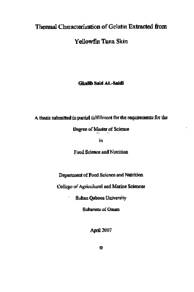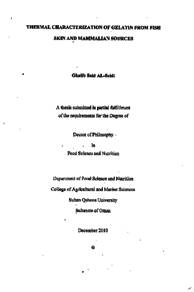Document
Thermal characterization of gelatin extracted from yellowfin tuna skin
Publisher
Sultan Qaboos University
Gregorian
2007
Language
English
Subject
English abstract
In this research gelatin was extracted from yellowfin tuna skin by alkali washing followed by heating in acid medium. The extracted gelatin was air dried and then ground into powder. The yield of extracted soluble solids was 57.8% based on the total solids in the skin. Thermal characteristics of gelatin extracted were determined from the thermograms measured by Differential Scanning Calorimetry (DSC) and modulated DSC (MDSC). Initially thermal characteristics (glass transition, melting and deterioration) were determined for tuna and different commercial gelatins. It was difficult to compare the thermal transitions of the gelatin of different sources with varied moisture content or water activity, thus gelatin from different sources were equilibrated at relative humidity of 11.3, 52.9 and 75.3% and then thermal transitions were measured. Tuna gelatin was more hygroscopic compared to mammalian source (bovine and porcine) since tuna gelatin adsorbed more moisture compared to others when equilibrated ať same level of relative humidity. DSC results indicated that tuna gelatin equilibrated at a constant relative humidity of 11.3, 52.9 and 75.3% showed lower glass transition compared to mammalian source gelatin (p<0.05). The glass transition of tuna gelatin equilibrated at 11.3% relative humidity was 30°C, which decreased to - 19°C when equilibrated at 52.9% relative humidity (p<0.05), however further increase of relative humidity to 75.3% showed insignificant change (p>0.05). Bovine and porcine samples equilibrated at 11.3 and 75.3% relative humidity showed significant differences in glass transition (p<0.05). However samples equilibrated at 52.9% relative humidity showed insignificant difference from the samples equilibrated at 11.3 and 75.3% relative humidity (p<0.05). In general, gelatin from different sources equilibrated with different water activities showed insignificant effect on the melting points (p>0.05). Glass transition was also determined from reversible heat flow thermogram of MDSC, which is a more sensitive and accurate method. The glass transition of tuna gelatin equilibrated at 11.3% relative humidity was 23°C, which decreased to -3°C when equilibrated at 52.9% relative humidity (p<0.05), however further increase of relative humidity to 75.3% showed significant increase to 12°C (p<0.05). In case of bovine gelatin, glass transition of samples equilibrated at 11.3% RH was 75°C, and then decreased for the samples equilibrated at 52.9% RH (p<0.05). Further increase in water activity had no effect on glass transition. However in the case of porcine gelatin water activity showed no effect on the glass transition. The results in this study showed that the degree of plasticization varied with the source of gelatin as well as their extraction methods.
Member of
Resource URL
Arabic abstract
خلاصة في هذا البحث أستخلص الجيلاتين (gelatin) من جلد سمك التونا(yellowfin Tuna) بالغسيل القلوي ثم التسخين في وسط حامضي. تم تجفيف الجيلاتين المستخلص بالهواء ثم طحنه كانت نسبة محصول المواد الصلبة القابلة للذوبان المستخلصة 57 . 8 % مستندة على المواد الصلبة الكلية في الجلد. تم تحديد الخصائص الحرارية للجيلاتين المستخلص من خلال الثيرموجرام (thermograms) باستخدام جهازي DSC و MDSC. أولا تم تحديد الخصائص الحرارية (المستوى الزجاجي والذوبان والتدهور) للجلاتين المستخلص من جلد سمك التونا والجيلاتين التجاري. كان من الصعب مقارنة الانتقالات الحرارية للجيلاتين من مصادر متنوعة وبنسب رطوبة مختلفة، لذا تم تعديل نسبة رطوبة الجيلاتين من المصادر المختلفة الى 11 . 3 , 52 . 9 و 75 . 3 % وبعد ذلك تم قياس الإنتقالات الحرارية. كان الجيلاتين من سمك التونا أكثر امتصاصا للماء (hygroscopic) بالمقارنة مع الجيلاتين التجاري ( الخنزيري والبقري). اوضحت نتائج التحليل الحراري لجيلاتين سمك التونا الموزون بنسب الرطوبة الثابتة 11 , 3و 52 . 9 و75 . 3 % آن المستوى الزجاجي اقل من التجاري الموزون بنفس نسب الرطوبة ( 0 . 05> p). كان الإنتقال الزجاجي الجيلاتين سمك التونا الموزون بنسبة 11 . 3 % رطوبة يساوي 30 درجة حرارة مئوية، الذي نزل إلى -19 درجة حرارة منوية عندما وزن في 52 . 9 % رطوبة نسبية ( 0 . 05> p) ، غير ان اظهرت الزيادة في الرطوبة النسبية إلى 75 . 3 % تغير غیر محسوس ( 0 . 05 <p). اظهرت العينات الحيوانية والخنزيرية الموزونة في 11 . 3 و75 . 3 % إختلافات هامة في الإنتقال الزجاجي ( 0 . 05> p). اظهرت العينات الموزونة في 52 . 9 % إختلافا غیر محسوس بالمقارنة بالعينات الموزونة في 11 . 3 و 75 . 3 % رطوبة نسبية ( 0 . 05> p) . غموما ,اظهر الجيلاتين من المصادر المختلفة الموزون بنشاطات الماء المختلفة تأثير غير محسوس على درجات الانصهار( 0 . 05 <p) . قرر أيضا الإنتقال الزجاجي من تدفق الحرارة القايل العكس من ثيرموجرام جهاز MDSC، الذي يعتبر طريقة حساسة وأكثر دقة. كان الإنتقال الزجاجي الجيلاتين سمك التونا الموزون في نسبة 11 . 3 % رطوبة 23 درجة حرارة مئوية ، الذي نزل إلى 3 درجة حرارة مئوية عندما وزن في 52 . 9 % رطوبة نسبية ( 0 . 05> p) ، غير أن الزيادة في نسبة الرطوبة إلى 75 . 3 % قد اظهرت زيادة هامة إلى 12 درجة حرارة مئوية ( 0 . 05> p). في حالة الجيلاتين الخنزيري، كان الإنتقال الزجاجي من العينات الموزونة في نسبة 11 . 3 % رطوبة يساوي 75 درجة حرارة مئوية، وبعد ذلك نزل للعينات الموزونة في نسبة 52 . 9 % رطوبة ( 0 . 05> p) .كان الزيادة الأخرى في النشاط الماني تأثير غیر محسوس على الإنتقال الزجاجي ( 0 . 05 <p) .كما اظهر النشاط المائي للجيلاتين الخنزيري تأثير غیر محسوس على الإنتقال الزجاجي( 0 . 05 <p) . اظهرت النتائج في هذه الدراسة بأن درجة اللدانة (plasticization) تفاوتت بمصدر الجيلاتين بالإضافة إلى طرق استخلاصها.
Category
Theses and Dissertations


